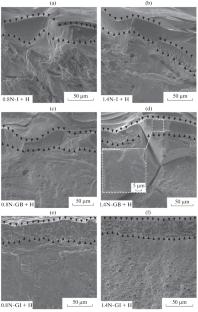Fe20Mn20Cr20Ni20Co19.2N0.8和Fe20Mn20Cr20Ni20Co18.6N1.4多组分合金组织和相分布对氢脆的影响
IF 0.3
Q4 METALLURGY & METALLURGICAL ENGINEERING
引用次数: 0
摘要
摘要:研究了含有分散Cr2N颗粒的Fe20Mn20Cr20Ni20Co20-xNx合金(x = 0.8, 1.4 at %)的氢脆。与颗粒均匀分布的细晶结构不同,晶界氮化物的形成有利于氢脆指数的降低。描述了合金析出硬化过程中形成的界面对氢致脆表面区断裂微观机制的影响。本文章由计算机程序翻译,如有差异,请以英文原文为准。

Influence of Microstructure and Phase Distribution on the Hydrogen Embrittlement of Multicomponent Alloys Fe20Mn20Cr20Ni20Co19.2N0.8 and Fe20Mn20Cr20Ni20Co18.6N1.4
Abstract—The hydrogen embrittlement of Fe20Mn20Cr20Ni20Co20–xNx alloys (x = 0.8, 1.4 at %) with disperse Cr2N particles is studied. The formation of grain-boundary nitrides is shown to favor a decrease in the hydrogen embrittlement index, unlike a fine-grained structure with homogeneously distributed particles. The influence of the interfaces formed during precipitation hardening of the alloys on the fracture micromechanisms in the hydrogen-induced brittle surface zone is described.
求助全文
通过发布文献求助,成功后即可免费获取论文全文。
去求助
来源期刊

Russian Metallurgy (Metally)
METALLURGY & METALLURGICAL ENGINEERING-
CiteScore
0.70
自引率
25.00%
发文量
140
期刊介绍:
Russian Metallurgy (Metally) publishes results of original experimental and theoretical research in the form of reviews and regular articles devoted to topical problems of metallurgy, physical metallurgy, and treatment of ferrous, nonferrous, rare, and other metals and alloys, intermetallic compounds, and metallic composite materials. The journal focuses on physicochemical properties of metallurgical materials (ores, slags, matters, and melts of metals and alloys); physicochemical processes (thermodynamics and kinetics of pyrometallurgical, hydrometallurgical, electrochemical, and other processes); theoretical metallurgy; metal forming; thermoplastic and thermochemical treatment; computation and experimental determination of phase diagrams and thermokinetic diagrams; mechanisms and kinetics of phase transitions in metallic materials; relations between the chemical composition, phase and structural states of materials and their physicochemical and service properties; interaction between metallic materials and external media; and effects of radiation on these materials.
 求助内容:
求助内容: 应助结果提醒方式:
应助结果提醒方式:


